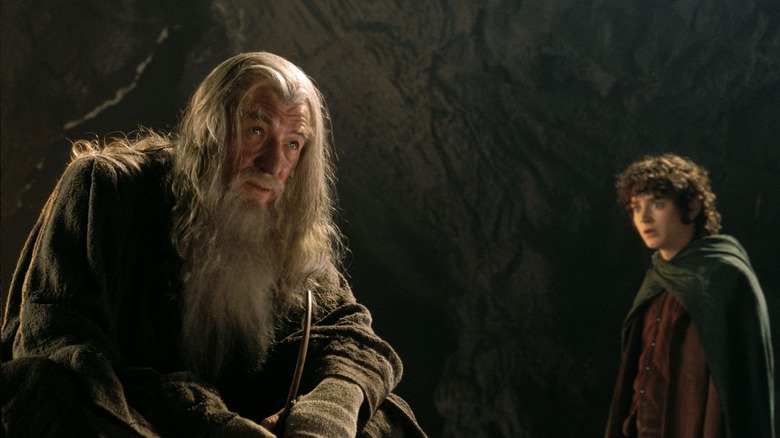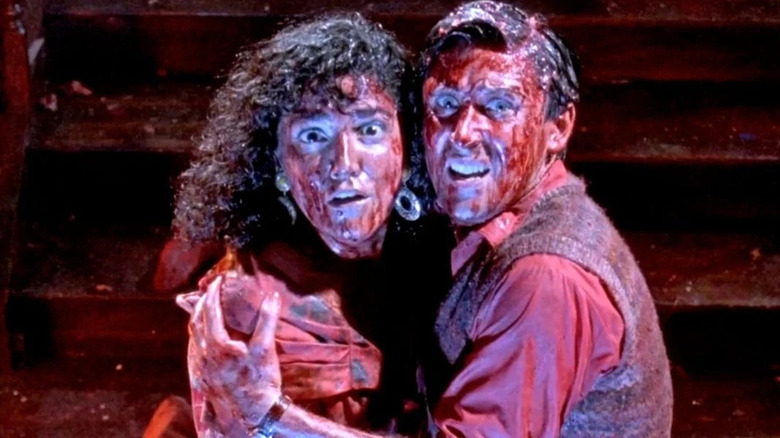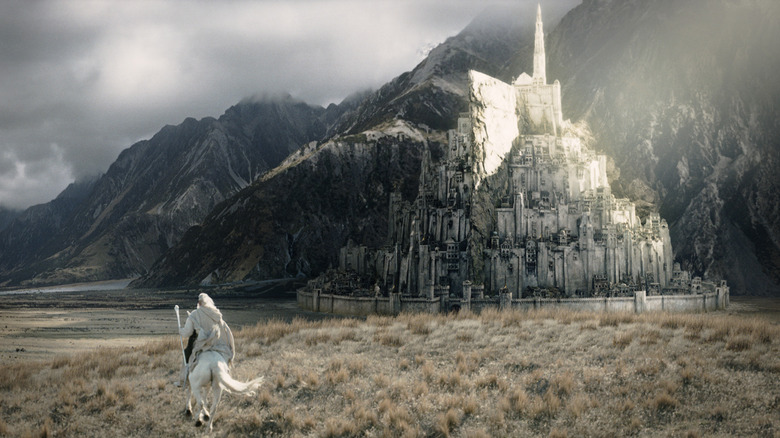Peter Jackson's Indie Movie Roots Let The Lord Of The Rings Effects Run Wild
Bringing J.R.R. Tolkien's beloved "The Lord of the Rings" fantasy series to the screen was an enormous undertaking, especially for an indie New Zealand filmmaker who had never made a film with such a pricey budget of $281 million before. But director Peter Jackson's homespun approach to making the epic trilogy actually worked in his favor.
The filmmaker told Fresh Air in 2002 how he was allowed to make the films "the new Zealand way, not the Hollywood way," thus producing one of the greatest cinematic trilogies of all time:
"We made it the New Zealand way, not the Hollywood way ... we still shot it as a low-budget film and so all that surplus money could go straight onto the screen. So we were able to build enormous sets and have hundreds of extras and, you know, hundreds and hundreds of computer shots and all the wonderful costumes ... that's where all our money got spent, which we'd never been able to do before. ... So now we had all the money that we needed to bring this world to life."
Jackson used many of the same techniques for "The Lord of the Rings" as his other independent films such as shooting in his native New Zealand and using his pre-established companies, WETA Workshop and WETA digital, for the groundbreaking special effects. He did not over-rely on CGI, using practical effects and specialized makeup to construct a rich and authentic Middle-earth."The Lord of the Rings" is visually dynamic because Peter Jackson draws on the unique style he developed while making crafty indie features on a shoestring budget.
Makeup effects for strange creatures
Not everything in "The Lord of the Rings" was created with expensive computer imagery. Peter Jackson relied on many old-fashioned, practical effects that he learned to use in his early career. The grotesque creatures of the Orcs and Uruk-hai in "The Lord of the Rings" were actors in prosthetic makeup.
Jackson created gruesome makeup effects for the gun-wielding aliens and the carnage they wreaked in his first feature film "Bad Taste," with one scene featuring the back of his skull opening and leaking squishy brain matter. "Dead Alive" (also known as "Braindead") amplifies the gore to the extreme. Much of the film uses synthetic makeup (as well as models and puppets) to create the zombies that are barbarically slashed to death with a lawnmower in the revolting and hilarious finale, their limbs and internal organs flying everywhere in a grandiose bloodbath. Den of Geek drew the connection between these early lo-fi films and "Lord of the Rings, describing how Jackson shoots this "convoluted set-piece with panache and clarity, deftly moving between genuine horror and hilarious sight gags ... [setting] a clear precedent for the large-scale battles of 'Lord Of The Rings," such as when Legolas rides down an Oliphant's trunk in the Pelennor Fields.
In his more serious drama "Heavenly Creatures," Jackson and his frequent special effects collaborator Richard Taylor use over 70 full-sized latex costumes to create the life-size plasticine figures that Pauline and Juliet play with in their sumptuous fantasy world. Special makeup was also used for "The Frighteners" where Richard Taylor and famed makeup artist Rick Baker created decaying, hollow-eyed ghosts. The material use of makeup gives "The Lord of the Rings" monsters a tangible authenticity that was sadly lost in "The Hobbit" trilogy with the CGI character of Azog.
Miniatures to bring big worlds to life
Another important practical effect that Peter Jackson used in "The Lord of the Rings" was "bigatures," Weta Workshop's name for a very large miniature model. The bigatures were massive and impeccably detailed — often taller than the crew members who created them. They were used for significant settings such as Rivendell, Minas Tirith, and The Black Gate. Jackson worked extensively with miniatures throughout his early career because of his smaller budget, but with the costly "The Lord of the Rings," miniatures would provide a realistic and physical depth that could not be fully recreated with CGI.
The alien house that crumbles and transforms into a giant spaceship at the end of "Bad Taste" was a rudimentary model built by Jackson himself. He also helped build an incredibly detailed miniature of Wellington in the 1950s — complete with old-fashioned cars and shop signs — for "Dead Alive" because he did not have the financial means for a real-life, full-scale recreation of the era. "The Frighteners" also uses miniatures to create a believable vision of Midwest America after Jackson petitioned to shoot the film in his native country of New Zealand.
Unlike his past low-budget films, Peter Jackson did not have to worry about finding the financial means to bring Tolkien's enchanting world to life. He had technological and production capabilities he never had before, but Jackson's decision to include many practical effects from the skills he cultivated as an indie filmmaker is part of what makes the trilogy a timeless triumph.


